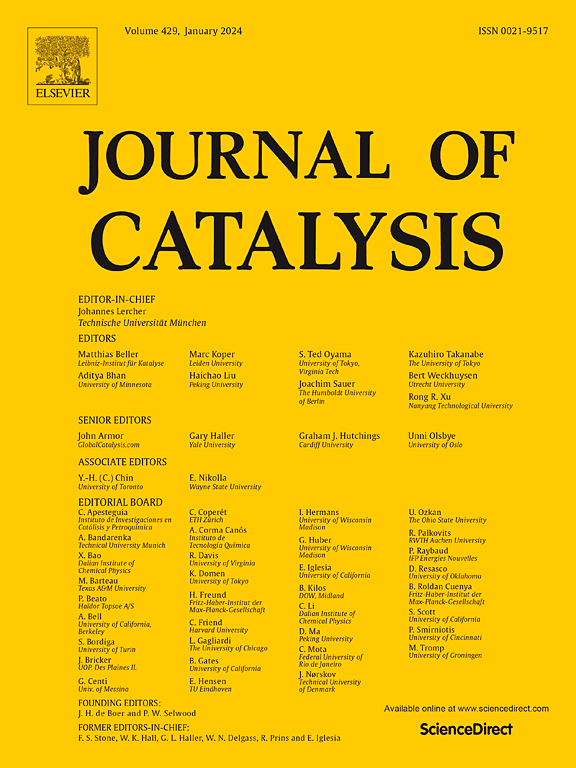一个预测菲利普斯催化剂诱导时间的适应性模型
IF 6.5
1区 化学
Q2 CHEMISTRY, PHYSICAL
引用次数: 0
摘要
菲利普斯催化剂占世界线性聚乙烯的很大一部分,众所周知,它的诱导期没有明显的乙烯消耗,随后是一段上升的活性期,这段时间可以持续一两个小时。在这项调查中,痕量的无处不在的污染物,分子氧,对诱导期的长度的影响是确定的。实验在管流式反应器中进行,填料床为1或3 wt% Cr / SiO2。该方案是首先在600 °C的温度下在50 %的O2中处理Cr(VI)/SiO2,然后通过惰性气体吹扫冷却并调整反应器入口残余O2浓度至约50至500 ppm之间,可选择使用1-己烯作为还原剂。聚合反应温度为100 ℃,乙烯分压为10 ~ 18 kPa。诱导时间的长短和达到最大活性的时间与入口O2浓度有关。用浆液催化剂进行高压(3.79 MPa)实验,定性地证实了这一观察结果,也证明了O2的作用是短暂的,催化剂达到了充分的聚合活性。提出了一种适用于填料床反应器中还原速率和再氧化速率竞争的适应性模型,该模型能根据氧浓度和催化剂负载量准确预测诱导时间的长度。本文章由计算机程序翻译,如有差异,请以英文原文为准。


An adaptable model to predict the induction time of the Phillips catalyst
The Phillips catalyst, which accounts for a large fraction of the world’s linear polyethylene, is known for an induction period without appreciable ethylene consumption, followed by a period of rising activity, which together can last an hour or two. In this investigation, the effect of trace amounts of a ubiquitous contaminant, molecular oxygen, on the length of the induction period is determined. Experiments were conducted in a tubular flow reactor with a packed bed of 1 or 3 wt% Cr on SiO2. The protocol was to first treat Cr(VI)/SiO2 at a temperature of 600 °C in 50 % O2, then cool and adjust the residual O2 concentration at the reactor inlet to between about 50 to 500 ppm by an inert gas purge, with optional application of 1-hexene as reductant. Polymerization was conducted at a temperature of 100 °C and ethylene partial pressures of 10 to 18 kPa. The length of the induction period and the time to reach maximum activity correlated with the O2 concentration at the inlet. The observations were qualitatively confirmed by high-pressure (3.79 MPa) experiments with slurried catalyst, which also demonstrated that the effect of O2 can be transient, and the catalyst reaches its full polymerization activity. An adaptable model of competing reduction and reoxidation rates in the packed-bed reactor is presented that accurately predicts the length of the induction time based on O2 level and the amount of catalyst loaded into the reactor.
.
求助全文
通过发布文献求助,成功后即可免费获取论文全文。
去求助
来源期刊

Journal of Catalysis
工程技术-工程:化工
CiteScore
12.30
自引率
5.50%
发文量
447
审稿时长
31 days
期刊介绍:
The Journal of Catalysis publishes scholarly articles on both heterogeneous and homogeneous catalysis, covering a wide range of chemical transformations. These include various types of catalysis, such as those mediated by photons, plasmons, and electrons. The focus of the studies is to understand the relationship between catalytic function and the underlying chemical properties of surfaces and metal complexes.
The articles in the journal offer innovative concepts and explore the synthesis and kinetics of inorganic solids and homogeneous complexes. Furthermore, they discuss spectroscopic techniques for characterizing catalysts, investigate the interaction of probes and reacting species with catalysts, and employ theoretical methods.
The research presented in the journal should have direct relevance to the field of catalytic processes, addressing either fundamental aspects or applications of catalysis.
 求助内容:
求助内容: 应助结果提醒方式:
应助结果提醒方式:


